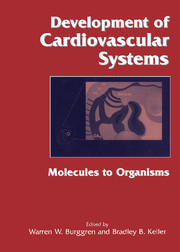Book contents
- Frontmatter
- Contents
- List of contributors
- Foreword by Constance Weinstein
- Introduction: Why study cardiovascular development?
- Part I Molecular, cellular, and integrative mechanisms determining cardiovascular development
- 1 Genetic dissection of heart development
- 2 Cardiac membrane structure and function
- 3 Development of the myocardial contractile system
- 4 Vasculogenesis and angiogenesis in the developing heart
- 5 Extracellular matrix maturation and heart formation
- 6 Endothelial cell development and its role in pathogenesis
- 7 Embryonic cardiovascular function, coupling, and maturation: A species view
- 8 Hormonal systems regulating the developing cardiovascular system
- Part II Species diversity in cardiovascular development
- Part III Environment and disease in cardiovascular development
- Epilogue: Future directions in developmental cardiovascular sciences
- References
- Systematic index
- Subject index
8 - Hormonal systems regulating the developing cardiovascular system
from Part I - Molecular, cellular, and integrative mechanisms determining cardiovascular development
Published online by Cambridge University Press: 10 May 2010
- Frontmatter
- Contents
- List of contributors
- Foreword by Constance Weinstein
- Introduction: Why study cardiovascular development?
- Part I Molecular, cellular, and integrative mechanisms determining cardiovascular development
- 1 Genetic dissection of heart development
- 2 Cardiac membrane structure and function
- 3 Development of the myocardial contractile system
- 4 Vasculogenesis and angiogenesis in the developing heart
- 5 Extracellular matrix maturation and heart formation
- 6 Endothelial cell development and its role in pathogenesis
- 7 Embryonic cardiovascular function, coupling, and maturation: A species view
- 8 Hormonal systems regulating the developing cardiovascular system
- Part II Species diversity in cardiovascular development
- Part III Environment and disease in cardiovascular development
- Epilogue: Future directions in developmental cardiovascular sciences
- References
- Systematic index
- Subject index
Summary
Introduction
The cardiovascular system is the first systemic organ to function in ontogenesis, and the stability of the system is essential for normal organogenesis of the embryo. In the mature individual, the autonomic nervous system and the endocrine system are vital for maintenance of the homeostasis of circulation, but both systems mature and begin to function at late stages of organogenesis or after birth. It has been thought that before these systems participate in cardiovascular control, the embryonic cardiovascular system is controlled exclusively by intrinsic characteristics of the heart, such as the Frank-Starling mechanism (Wagman, Hu, & Clark, 1990), and by changes of heart rate and vascular resistance to environmental temperature (Nakazawa etal., 1985; Nakazawa etal., 1986).
In addition to intrinsic mechanisms, atrial natriuretic peptide is present in the embryonic myocardium as early as day 11 of gestation in the rat (Toshimori et al., 1987; Scott & Jennes, 1988). The gene for atrial natriuretic peptide is first expressed at day 8 in mouse embryonic myocardial cells (Zeller et al., 1987), although the amount of the peptide is much less than that in late gestation or in the mature heart (Dolan & Dobrozsi, 1987). Atrial natriuretic factor is present in the human embryo heart at 8–9 gestational weeks, when ventricular septation is almost completed (Larsen, 1990). Atrial natriuretic factor is a potent vasodilator and reduces venous return in the early chick embryonic circulation (Nakazawa et al., 1990a; Hu et al., 1994); therefore, this peptide could have a hemodynamic role via an endocrine or paracrine pathway in the prenephric system.
- Type
- Chapter
- Information
- Development of Cardiovascular SystemsMolecules to Organisms, pp. 88 - 98Publisher: Cambridge University PressPrint publication year: 1998



